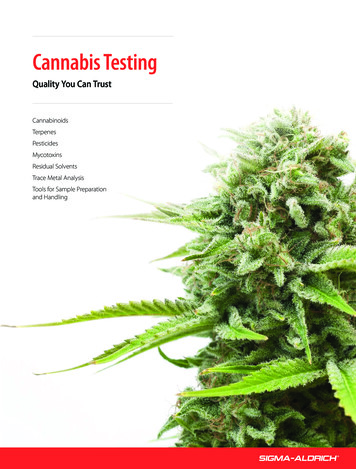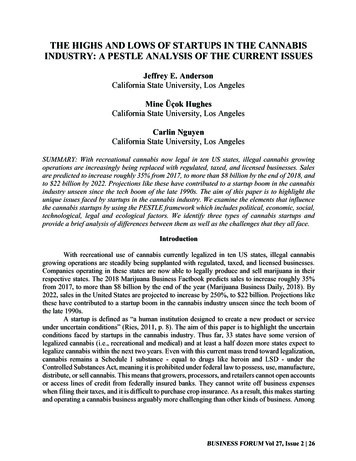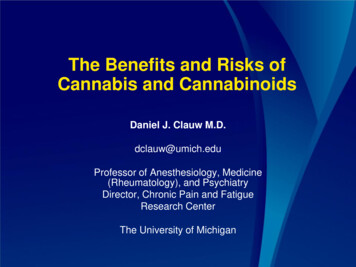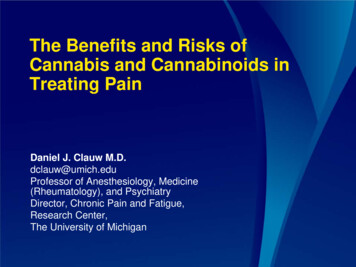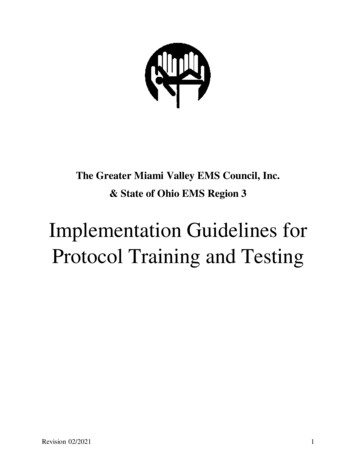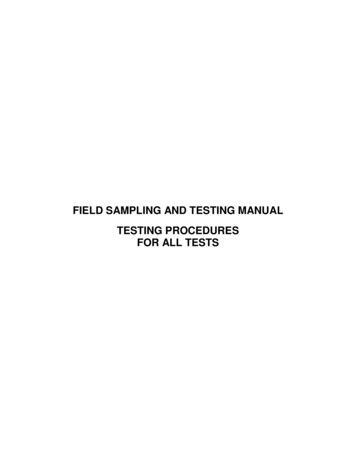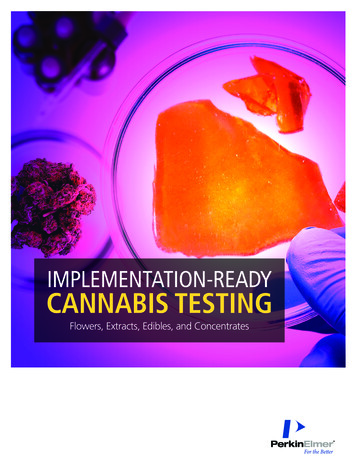
Transcription
Image AreaIMPLEMENTATION-READYCANNABIS TESTINGFlowers, Extracts, Edibles, and Concentrates
ANALYSISFROM SEEDTO FINALPRODUCT2
PARTNER WITH PERKINELMERAnalyzing cannabis can be challenging – setting up a laboratory, developingmethods to ensure maximum throughput of samples, generating clientreports, and preserving data integrity. More importantly, as state and countryrules and regulations evolve, cannabis labs need instrumentation and supportthat can meet new and stricter demands. Difficult matrices like these requirethe highest sensitivity and greatest performance than ever before. And frompesticides and mycotoxins to residual solvents and terpenes to potency andheavy metals, our instruments will help you analyze quickly and accurately.Whether your lab is well established or just starting up, having a single-sourcepartner who can offer turnkey solutions that meet the current regulations isessential to a successful business. For years, we’ve worked with governmentand contract cannabis laboratories to develop industry-leading methods,technology, and exceptional return on investment. We help drive analyticalstandards and commit to ensuring your laboratory has maximum uptime.Meet the newest, most elitemember of the QSight familyCompared to its predecessors, theQSight 400 LC/MS/MS instrumenthas superior sensitivity, which candetect analytes present at parts pertrillion concentrations. Plus, it has thesame unique features you’ve alwaysloved about the QSight instrument,such as StayClean and dual-sourcetechnologies.Learn about our various testing methods and applications for cannabisanalyses. Let us work with you to build an efficient workflow, so you canfocus on growing your business and brand.CANNABIS TESTING AT A GLANCEPESTICIDES, MYCOTOXINSPOTENCY CANNABINOIDSInstrument Family:QSight Triple QuadThree models to choose from, dependingon your sensitivity requirementsInstrument: Flexar HPLCTechnology:UHPLC LC/MS/MSBenefits: High-selectivity and high-sensitivitytests for compounds in different sample matricesRESIDUAL SOLVENTS, TERPENESInstruments:Clarus SQ 8 and TurboMatrix Technology: HPLCBenefits: Chromatographicseparation and quantitative monitoringof primary cannabinoidsInstrument: Spectrum Two N Technology: FT-NIR SpectrometerBenefits: Enables simple andreliable NIR analysisTechnology:GC/MS with headspace (GC/MS-HS)HEAVY METALS AND MINERALSBenefits: Works together to analyzeaccurately and save timeInstruments:NexION 2000 and Titan MPS Technology: ICP/MS and microwavedigestion sample prepBenefits: Works together to effectivelyanalyze cannabis for nutritional andtoxic elementswww.perkinelmer.com/cannabis3
PESTICIDESANALYZING WITH LC/MS/MSHighlights of the Turnkey Method forPesticide and Mycotoxin AnalysisRESILIENCE, AND EASY SAMPLE PREP Ability to analyze all North America-regulated pesticidesand mycotoxins on a single LC/MS/MSFOR SUPERIOR SELECTIVITY, SENSITIVITY, Eliminates the need for GC/MS by using APCI source (APCIused for pesticides such as PCNB and Chlordane)High-performance liquid chromatography tandem massspectrometry (LC/MS/MS) has emerged as the method of choicefor pesticide and mycotoxin analysis in cannabis. Traditionally,pesticides are screened using two analytical instruments: GC-MS/MSand LC/MS/MS. However, most of the studies for the two-systemtechnology approach either do not achieve state action limits orrequire multiple time-consuming sample preparation methods andinstrument consumables. StayClean technology addresses matrix-inducedmaintenance issues in the MS instrument and improvesthroughput Provides a reliable and reproducible method and SOP withLOQs below state of California action limits Features simple and fast sample preparation procedurewith acceptable recoveries for all analytesOur QSight triple quad LC/MS/MS uses a single instrument and singleprep method for rapid, reliable results – suitable for labs wanting tocomply with stringent regulations. This method allows identificationand quantification of all pesticides and mycotoxins at levels wellbelow action limits (0.005 to 0.25 μg/g). The ability to screen andquantitate the hydrophobic and chlorinated compounds normallyanalyzed on a GC/MS, as well as all the mycotoxins, makes it theideal analytical technique for the cannabis industry. Complete application solution includes analysis ofmycotoxins and pesticides with one instrument (samplepreparation, chromatography, and mass spectrometry)The QSight system’s unique dual source technology allows you to run all California state-regulated pesticides on one instrument. It eliminates the need forGC/MS analysis by using the APCI source to detect chlordane and pentachloronitrobenzene. Additionally, it captures trace amounts of tricky pesticidessuch as captan, chlorfenapyr, cypermethrine, cyfluthrin, naled, permethrin, and ethrineCypermethrinePermethrinPermethrin
PESTICIDESDual SourceHSID InterfaceTwo independentprobes provide truemultiplexing flexibilityProvides low background andreliable results and reduces thenumber of parameters to manageStayClean SourceSelf-cleaning design deliversmaximum sensitivity andexceptional uptimeLaminar Flow Ion GuideHighly efficient field-freetransmissionCollision CellMass FiltersFast, efficient fragmentation(fast MRMs) shortens cycletime with zero crosstalkHigh-quality precisionrods provide highly stable,precise mass filteringUniField DetectorModularPatented technologycounts positive andnegative ions withouthigh-voltage switchingPlug-and-play design forease of serviceSmall Footprint, Vertical DesignCompact 50 cm x 50 cm x 115 cm –no benchtop lClClCClClN SO ClON HCl2ClHChlordaneChlordaneCaptanCaptan5
RESIDUAL SOLVENTSPREVENT END-PRODUCT CONTAMINATIONMost cannabis concentrates are extracted using a solvent suchas supercritical CO2, butane, hydrocarbon (hexane), propane,water (ethanol) or alcohol. These solvents are used to extract outthe cannabinoids and terpenes from the plant material. In somecases, impurities from the solvent remain in the final cannabisproduct. These are called residual solvents and understanding theirconcentration is a critical element of cannabis testing.The method of choice for quantifying residual solvents is headspacegas chromatography, a simple technique that allows only the volatilecomponent of the cannabis sample to be measured.Our preinstalled method for GC/MS-HS technology leverages theidentical instrumentation required for terpene analysis, allowing thestreamlined lab to run both tests simultaneously.Residual solvent analysis byGC/MS-HS, in compliancewith guidelines for theCalifornia market.Some of the most common residual solvents tested by GC/MS-HS are: butane, propane, ethanol, isopropanol,methanol, acetone, benzene, toluene, and ylIsopropyl anolPropanePropaneMethanolMethanol
TERPENESISOLATING, IDENTIFYING, AND ANALYZING TERPENESFrom oranges to cannabis, terpenes are found in the oils of allbotanicals and are often responsible for the distinct flavors andfragrances consumers recognize. By leveraging unique terpenesand key cannabis strains, growers, processors, and producers candifferentiate themselves – and their products – in this ever-growingmarket. Additionally, the potential medical benefits of terpenes arecontinually explored and new analysis opportunities surge.Terpene analysis is run on a GC/MS-HS. With easy samplepreparation, this laboratory analysis can be used to look at morethan 140 terpenes of varying concentrations.Terpene analysis byGC/MS-HS, showingdistinct separation ofthe terpenes found inthe test sample.From Regulation Requirements to Strain ConsistencyWhether you are focused on meeting stringent regulations or on maintaining strainconsistency, the Clarus SQ 8 GC/MS is unsurpassed in both sensitivity and stability.Coupled with the TurboMatrix headspace sampler and engineered to deliverunparalleled precision, accuracy, and productivity, the Clarus GC/MS system is theclear choice for laboratories serving the cannabis market.Clarus GC/MS with TurboMatrix HeadspaceHighly valued for revenue or for research, terpenes are strain dependent and can be difficult to analyze due to complicated coleutions.The addition of the headspace to the GC/MS system minimizes analytical challenges and allows for accurate terpene inaloolGeraniolGeraniolMyrceneMyrcene7
POTENCYTHE NEED FOR CANNABINOIDPOTENCY TESTINGNaturally occurring cannabinoids, the main biologically activecomponents of the cannabis and hemp plant, form a complexgroup of closely related compounds, of which 70 are knownand well described. Of these, the primary focus has been onΔ9-tetrahydrocannabinol (THC) due to its pharmacological andtoxicological characteristics, upon which strict legal limits havebeen enforced. Cultivators and processing labs often focus onΔ9-tetrahydrocannabinolic acid (THC-A), as it is the naturallyoccurring precursor to THC and is readily decarboxylated to THCvia the drying and/or heating of cannabis.Full Cannabinoid Quantification with HPLCOur application describes a method for the chromatographicseparation and quantitative monitoring of twelve primarycannabinoids, including THC, THC-A, CBD, and CBD-A, in cannabisflower extracts and edibles by HPLC combined with PDA detection.This technique employs our Flexar HPLC system, including aquaternary pump, autosampler with Peltier cooling, column heaterand PDA (photodiode array) detector.LC chromatogram showing separation of the 12 cannabinoids in the Level-6 standard.Quick and Nondestructive Analysis with FT-NIRIn addition, our Spectrum Two N with near-infrared reflectancemodule (NIRM) can determine the THCA/CDBA potency ratio inground cannabis flower. It’s a quick and nondestructive method thatrequires little to no sample preparation, no hazardous chemicals, andallows the sample to be reused in other analyses.Spectrum Two NFT-NIR SpectrometerFlexar HPLCSample preparation is critical when analyzing potency to achieve accurate quantification of the most commonly desiredcannabinoids: THC, CBD, CBN, and binolcbdvCBDV
MYCOTOXINSPREVENT THE SPREADOF CONTAMINATIONG1 B2In addition to pesticides, the growth of various moldsand fungi during the growing process can producecarcinogenic mycotoxins including ochratoxin A andaflatoxins. As a result, testing for levels of pesticidesand mycotoxins in cannabis is important to ensureconsumer safety and quality control, as these moleculescan be highly toxic to all animal organisms and haveharmful effects even at very low doses. Contaminationcan occur in the field, but also during the subsequentphases of transportation, storage, or processing, orwhen environmental conditions of temperature andhumidity are precise enough to develop fungal sporesnaturally present in the environment.B1G2M1Our mycotoxins method allows laboratories toquantitate at low levels (0.005 to 0.25 µg/g), whichis well below the actions limits set by the state ofCalifornia with good precision. That’s what makes thisa novel method for screening and measuring pesticidesand mycotoxins in cannabis with a single instrument.TICs of 1 ppb aflatoxin standardUHPLC with MS DetectorThe use of a universal MS detector, which includes the QSight 200and 400 series, allows the development of a single analytical methodwithout resorting to a system of derivatization. The QSight systemidentifies molecules, exploiting the ions generated when subjected toa process of ionization. Each toxin is analyzed in the most appropriateionization method: ESI or ESI -.QSight 200 or 400 series – ideal for pesticide analysisAs with potency, the QSight instrument comes with an SOP that outlines a method to test challenging matrices presented by mycotoxins.OOOOOHOOHOOClHONHHOOOOOOHHOOOOchratoxin AOchratoxin AHOOAflatoxin G1Aflatoxin G1OOOOHOOOAflatoxin G2Aflatoxin G2OAflatoxin B1Aflatoxin B1OOOAflatoxin B2Aflatoxin B29
HEAVY METALSENSURE SAFETY FOREND CONSUMERSHarmful toxic elements can be absorbed into cannabis plantsprimarily through uptake from soil, water, and fertilizer.Concentrations are at comparatively trace levels – in the parts perbillion or parts per trillion – but can still be harmful to end consumers.As such, it’s important to measure the toxic elemental content ofplants and plant materials. Cannabis and hemp plants are complexbiological entities that require sample preparation, usually consistingof homogenization followed by microwave digestion to completelybreak down the complex matrix and extract the elements. Despitethese steps, it’s still possible for matrix-induced spectral interferencesto persist, which may cause false readings, especially for the toxicelements. To ensure accuracy and compliance, our NexION ICP-MSincludes a detailed SOP that allows heavy metals, such as mercury,lead, arsenic, and cadmium, to be quantified in a cannabis lab.Microwave Digestion and ICP-MS MakesSampling Easy and EfficientThe NexION ICP-MS combined with a Titan MPS microwave systemcan effectively prepare and analyze cannabis for both nutritional andtoxic elements. Reproducible sample digestion is achieved throughprecise reaction control of temperature and/or pressure. Access tothe sample area from above, via a hinged lid, offers easy sampleaccess. The system employs 100 mL vessels and allows digestiontemperatures up to 260 C and pressures up to 100 irementsArsenic (As)0.031000.20Cadmium (Cd)0.02970.20Mercury (Hg)0.04970.10Lead (Pb)0.05870.50The data reveals the NexION's sens
focus on growing your business and brand. Meet the newest, most elite . member of the QSight family . Compared to its predecessors, the . QSight 400 LC/MS/MS instrument has superior sensitivity, which can detect analytes present at parts per trillion concentrations. Plus, it has the same unique features you’ve always loved about the QSight instrument, such as StayClean and dual-source .
